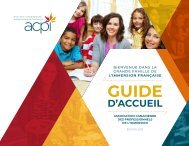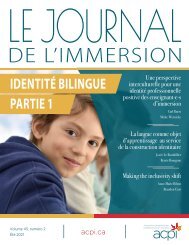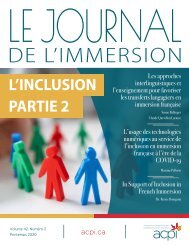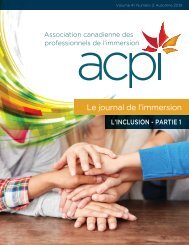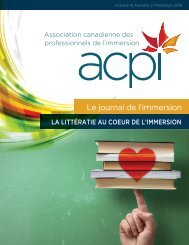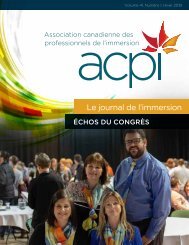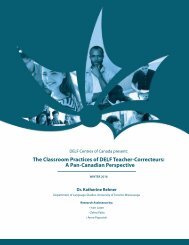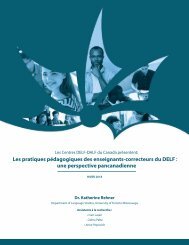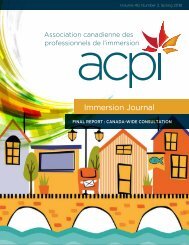Create successful ePaper yourself
Turn your PDF publications into a flip-book with our unique Google optimized e-Paper software.
<strong>Échos</strong> <strong>du</strong> congrès<br />
Challenges and Opportunities Around Teacher<br />
Recruitment and Retention in French Immersion<br />
Martin Poirier | E<strong>du</strong>cation Director for Languages, Calgary Board of E<strong>du</strong>cation | mapoirier@cbe.ab.ca<br />
A fast track line for recruitment<br />
The last two years of the pandemic<br />
have exacerbated the challenges<br />
that we were already facing of<br />
teacher shortage and retention<br />
(Pandey, 2022). At the Calgary<br />
Board of E<strong>du</strong>cation (CBE), we took<br />
on these challenges in accelerating<br />
three critical areas of practice:<br />
a fast track line for recruitment,<br />
robust onboarding practices, and<br />
rich professional learning.<br />
Our recruitment of teachers starts in high schools. As an<br />
increasing number of members of our faculty comes from<br />
the rank of our immersion programs, we have opened the<br />
doors of our high schools to our local faculties of e<strong>du</strong>cation<br />
that offer language programs, including both the Werklund<br />
School of E<strong>du</strong>cation at the University of Calgary and the<br />
Campus Saint-Jean at the University of Alberta. We have<br />
invited these schools to present to our grade 11 and 12<br />
classes. We are also working with our schools to welcome<br />
student teachers in their midst to offer the future teacher<br />
a taste of what a career would be like within our district.<br />
In addition, our recruiter will meet with the studentteachers<br />
and encourage them to apply with us. Once the<br />
successful practicum is completed, our recruiter offers a<br />
full year contract to the now qualified teacher. The role<br />
of the principal in this process is crucial in facilitating the<br />
session from universities to the school, and also identifying<br />
potential future faculty members through the practicum<br />
process. We also encourage them to be on the lookout for<br />
potential substitute teachers that would want to make the<br />
jump to a full-time contract.<br />
Robust onboarding practices<br />
As we know, teacher attrition is an ongoing challenge. As<br />
a school district, we took proactive steps to support our<br />
new teachers. Our first step is a welcome session in late<br />
August to intro<strong>du</strong>ce them to our district, and also to share<br />
with them the resources, lesson plans, and tasks that were<br />
created by colleagues over the years. It also gives us an<br />
occasion to intro<strong>du</strong>ce our language team and to let them<br />
know that we are there to support them. We also use this<br />
time to create a new community of practice. During the<br />
coming year, we will set up sessions around classroom<br />
management, use of our online platform, assessment<br />
practices, sharing of activities around common themes,<br />
and so forth. To support this process, we ask our principals<br />
to support our beginning teachers with employing wellknown<br />
practices: “assigning them effective mentors,<br />
providing tools to manage a classroom, and supporting<br />
their self-care.” (Whitaker, 2019)<br />
This latter practice, supporting self-care, has taken a<br />
greater importance in the last two years, and frankly<br />
applies to all of our teachers, requiring particular<br />
focus and attention from principals.<br />
For example, I would expect principals to be visible, in the<br />
hallways, in the classroom, encouraging and celebrating<br />
good practices. I would expect principals to limit their use<br />
of e-mails for communication, limiting length, number, and<br />
also in time. In time, meaning that an e-mail should not<br />
be sent after 6:00 p.m. or on the weekend, one can use the<br />
delay button. Teachers need the time to detach themselves,<br />
reconnect with family and friends, and refresh. These simple<br />
practices around e-mails are examples of walking the talk<br />
around teachers’ wellness.<br />
Rich professional learning<br />
In the previous section, I already mentioned a few areas<br />
where new teachers need support in their professional<br />
learning. In the last edition of the Journal de l’immersion,<br />
Culligan and Kristmanson gave us considerations around<br />
professional learning for French as Second Language<br />
teachers. The same area of interventions applies for French<br />
Immersion teachers, as they identified for us focus areas<br />
including language proficiency, pedagogical knowledge,<br />
and mentorships. At the Calgary Board of E<strong>du</strong>cation, we<br />
provide sessions around four themes, including numeracy,<br />
assessment, wellness, and literacy in the target language.<br />
For the latter theme, in this case French, our professional<br />
development has three goals: developing our teachers to<br />
become experts in the five principles of the neurolinguistics<br />
approach (Netten & Germain, 2012), working with our<br />
teachers to develop common assessment standards<br />
and practices around reading, writing, listening and oral<br />
expression, and developing their own language skills.<br />
The first two goals are done by offering summer sessions<br />
46 | LE JOURNAL DE L'IMMERSION



